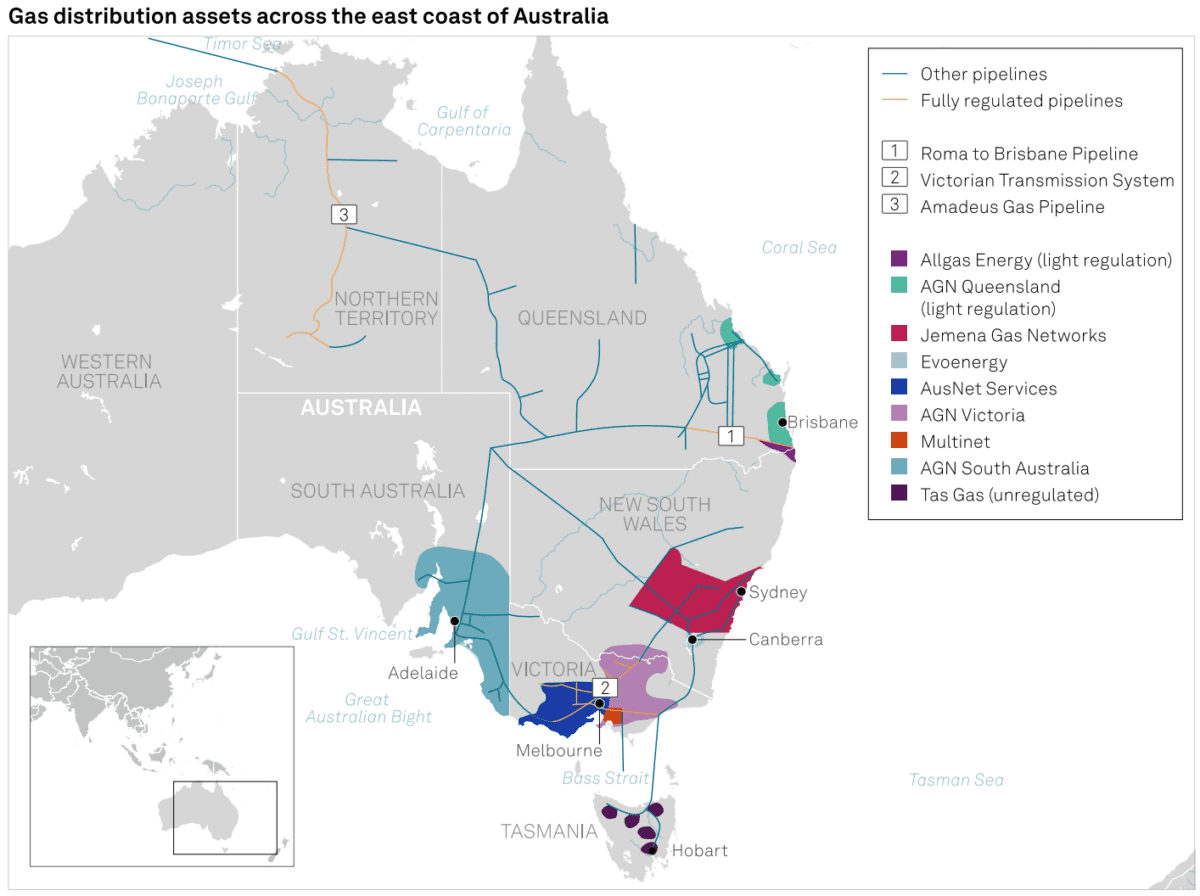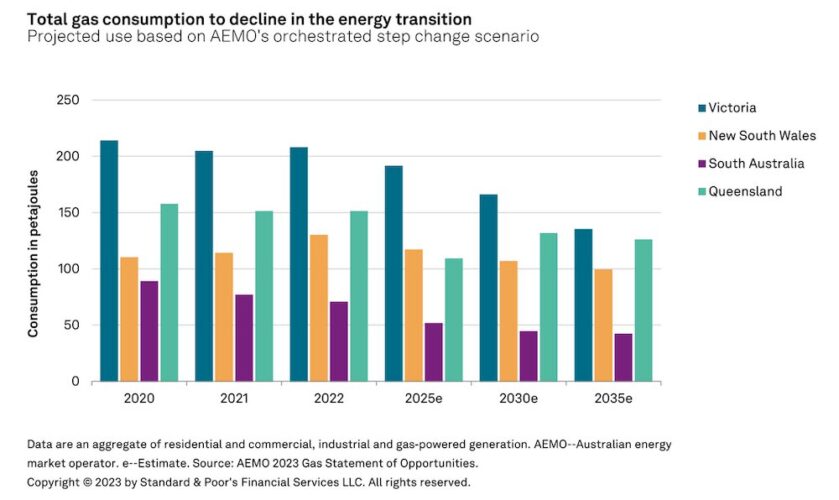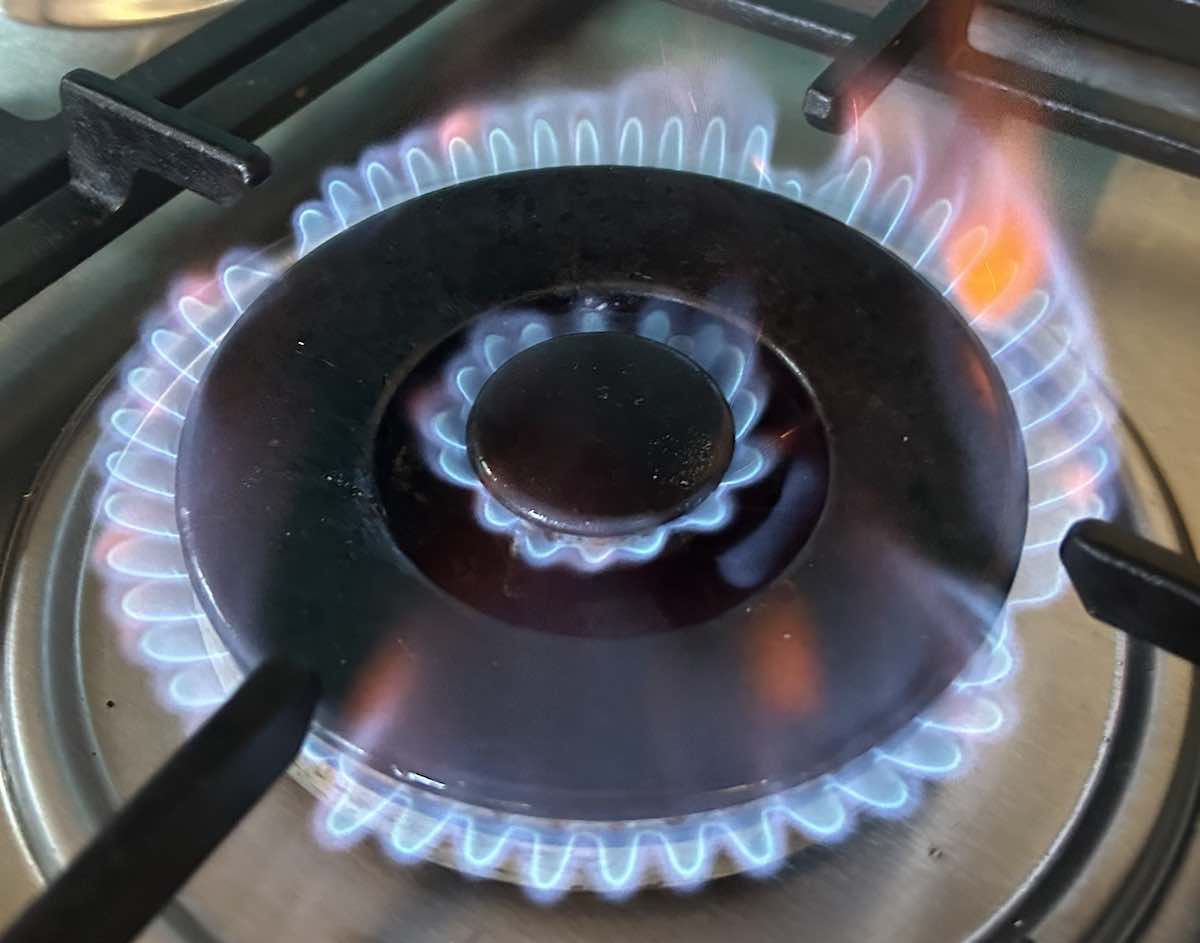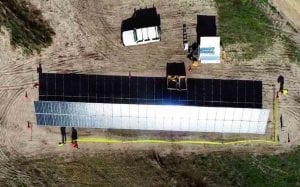International credit rating agency S&P says Victoria’s 2024 ban on new gas connections might be the beginning of the end for gas distributors – but it says that the end will take a long time.
The shift in thinking towards household gas, led by the ACT and continued by the Victoria state government in July, and more recently councils in NSW, signals a “new urgency” to curtail gas use, S&P analysts Parvathy Iyer and Limmy Ly write in a new report.
They say the shift in thinking is putting gas distributors around the country on the path of managed decline, with long term risks from changing government policies and regulations, possible alternate use of their assets, the pace of growth in renewable energy, and how the asset owners react financially to the above changes.
“While we do not expect these factors to affect ratings for the next five to 10 years, afterwards the effects could be meaningful,” they wrote in an analysis titled “Energy Transition Puts Australian Gas Distributors On Track For A Managed Decline”.
“As gas volumes decline, business risks will rise, particularly if regulators do not implement offsetting measures or alternate use of pipelines does not emerge. It invites many questions about how the regulatory climate in Australia will adapt to the emerging changes.”

The S&P report found the ban will have a limited but immediate hit on the credit quality of gas distribution companies – given the highly leveraged nature of the industry.
If banning new gas connections becomes a trend among governments the business of gas distribution will be at risk, if regulators don’t allow pipelines to be used for other things, such as hydrogen or biomethane, which the writers dismissed today as being more expensive than both gas and electricity and which come with their own complications.
And although new connections only account for 1-2 per cent of total connections in Victoria every year, it is a sign the asset base is set to decline – and will mean distributors will need to start cutting debt sooner than planned.
And even though South Australia, Queensland, New South Wales and Western Australia have ruled out gas bans for now, moves towards electrification are happening across the eastern seaboard.
In 2022 there was the National Construction Code for Residential Energy Efficiency and the Federal Government Electrification Program, and this year saw the NSW Electrification Pilot Scheme, and the Queensland supergrid plan.
Whether regulators will allow the rising costs of lower gas use to be socialised over the remaining users is a question yet to be answered, Iyer told RenewEconomy.
Already the Victoria government has capped disconnection costs for residents.
“It’s a question we can’t really answer yet as it differs from state to state. In Victoria residential users are much higher because of the space heating and also because of the fact that industrial usage is lower than in the other states, predominantly because of the location of manufacturing,” she says.
“That is one question that the regulator will have to come up with, and it will be seen in light of cost of living pressures [and other government measures].”
What to do about stranded assets, and where these are likely to be, is a question likely to be answered in the 2030s, she says.
“We will come to know more about this maybe around the 2030s as to what is going to be the level of penetration of renewables cover, batteries into households, and what is the cost of having those relative to gas.”
The fall and fall of gas
Victoria, the largest user of residential gas in Australia, is banning gas connections to new homes and residential subdivisions, after outrage over gas industry attempts to get homeowners to switch from electric to gas.
The ACT passed a landmark law in June with a similar ban which starts from January 1, 2024.
The Australian Energy Market operator (AEMO) estimates gas use in the eastern states – already in decline for the past decade – will further diminish from 2035, but that will depend on what the gas is used for. (Eds note: The S&P uses the latest aggregate data from AEMO across residential, commercial, industrial and grid-scale generation.)

Residential gas use will drive the decline in some states, but in Queensland, for example, 70 per cent of gas use is industrial, and in NSW it’s 50 per cent.
In 2022, 60 per cent of gas used in Victoria went to residential users. In NSW that figure was 40 per cent, and in Queensland and South Australia it was 5-15 per cent.
Getting industrial users off gas is difficult, with new ideas still in the testing and demo phases, such as the Hadean Energy tech that Bluescope is testing at its Port Kembla steelworks. Dislodging existing residential gas connections will also take time.
“The transition is coming, but slowly and with care,” Iyer and Ly wrote.
If AEMO’s forecast that gas use will start really falling from 2035 comes true, gas distributors who spent the previous decade in denial will be hit by a series of problems.
Fewer new connections will mean lower capital investment, but at the same time abolishment costs are likely to rise – particularly if other states follow Victoria’s lead in capping those costs for consumers, are just two.
“Most gas distributors had anticipated a gradual decline in gas consumption over the coming years. This expectation comes amid a drop in building approvals, a soft economy, and fewer new gas connections following the release of Victoria’s gas substitution map in July 2022,” Iyer and Ly say.
“The larger factor will be a gradual hit on the asset base. Reduced new residential/public building connections in the next five years will reduce the level of capital investment. While this might increase rated entities’ free operating cash flows (after capex), this will result in lower growth, or a slow decline, in the RAB.
“Rated entities have decent headroom in their financial metrics to manage the transition. Importantly, the Victorian gas distribution assets of the rated entities form a portion of their portfolio. The diversity of assets offers protection to the rated entities and buys them time to manage their balance sheets.”










